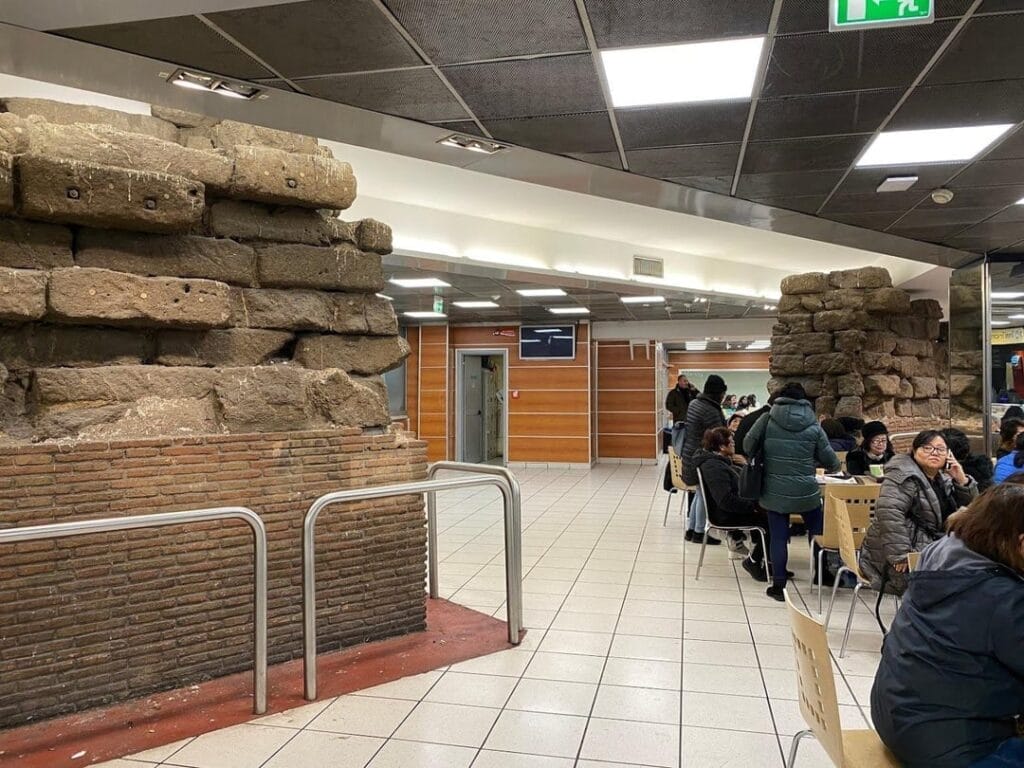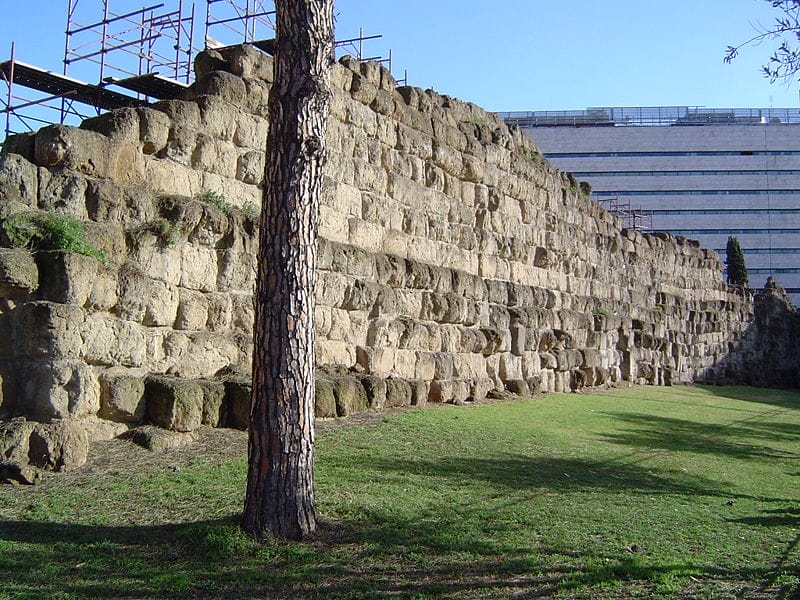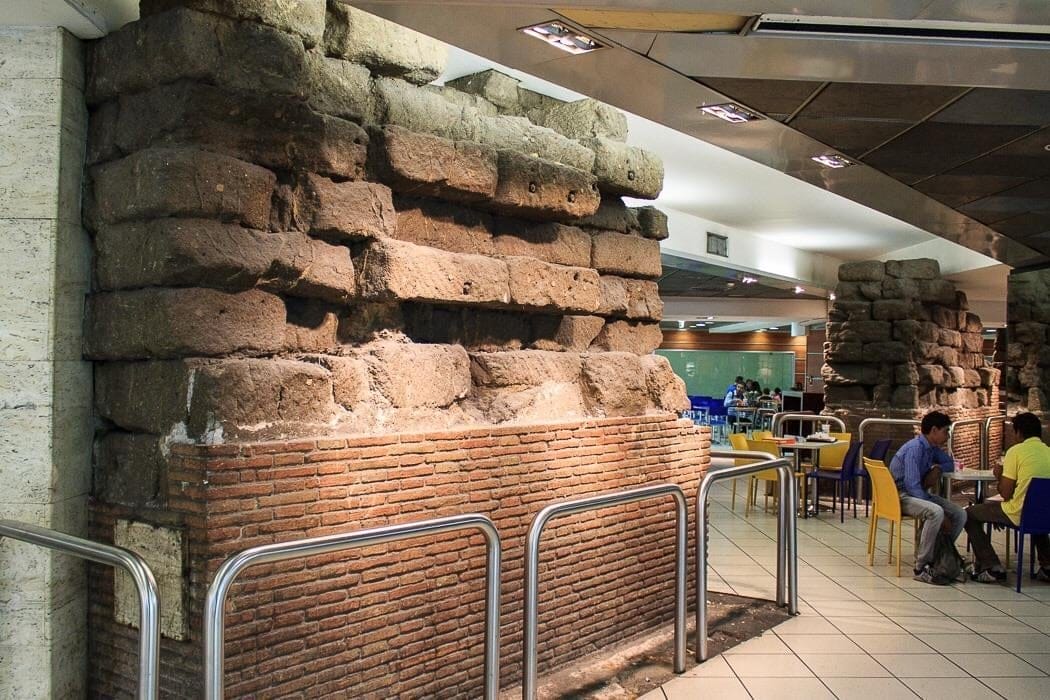In the busy heart of Rome lies an unexpected relic of ancient history—the Servian Wall. Built over 2500 years ago to fortify the ancient city of Rome, this remarkable archaeological site has found an unlikely home within a McDonald’s restaurant located in the Roma Termini train station. Tucked away beneath the modern façade of a McDonald’s restaurant, hidden in plain sight, is a section of the ancient Servian Wall.
The contrast between ancient history and modern fast food may seem incompatible at first glance, but it serves as a reminder of Rome’s rich and layered history, where the past and present coexist in unexpected ways. That is why we will delve into the fascinating story of the Servian Wall, exploring its historical significance, architectural features, and the unique challenges and opportunities presented by its integration into a contemporary urban environment.

The Origins of the Servian Wall
The Servian Wall, named after the sixth king of Rome, Servius Tullius, is one of the earliest defensive structures built to protect the ancient city. Constructed in the 4th century BC, the wall served as a vital fortification against external threats and played a crucial role in shaping the urban landscape of ancient Rome. Its origins lie within a period of transformation for the Roman Republic, marked by territorial expansion, socio-political changes, and the need for robust defense against external threats. Understanding the origins of the Servian Wall requires delving into the historical context of Rome during this era, exploring the factors that spurred its construction, and examining the engineering ingenuity behind its formidable design.

The construction of the Servian Wall was driven by the pressing need to fortify Rome against external threats posed by neighboring tribes and rival city-states. Throughout the 5th and 4th centuries BCE, Rome found itself engaged in frequent conflicts with neighboring powers, including the Etruscans, Samnites, and Gauls. These conflicts, often characterized by raids, skirmishes, and territorial disputes, underscored the vulnerability of Rome’s nascent urban center and the necessity of robust defensive infrastructure to safeguard its inhabitants and resources.
In response to these threats, the Roman state embarked on a concerted effort to bolster its defensive capabilities and fortify the city against future incursions. The construction of the Servian Wall emerged as a central component of this defensive strategy, symbolizing Rome’s determination to secure its borders and protect its burgeoning empire from external foes.
Stretching approximately 11 kilometers in circumference, the Servian Wall encircled the seven hills of Rome, including the Palatine Hill, where the city’s earliest settlements were concentrated. Constructed primarily of tufa blocks and limestone, the wall stood approximately 10 meters tall and featured a defensive rampart, battlements, and gates fortified with towers. Its strategic design incorporated natural topographical features, such as cliffs and ravines, to enhance its defensive capabilities, making it a formidable obstacle for would-be invaders.

The Rediscovery of the Servian Wall
For centuries, the Servian Wall lay hidden beneath the bustling streets of Rome, its existence known only through ancient texts and archaeological speculation. It wasn’t until the late 19th century that extensive excavations led to the rediscovery of significant sections of the wall, including the stretch that now resides within the confines of the Roma Termini train station. Archaeologists embarked on ambitious excavation projects, uncovering sections of the wall buried beneath layers of earth and debris.
One such section was discovered beneath the site of the Roma Termini station, then under construction. To the surprise of many, archaeologists unearthed a remarkably well-preserved portion of the Servian Wall, complete with its original stonework and defensive features. Recognizing the historical significance of the find, efforts were made to incorporate the ancient structure into the design of the modern railway station. This surprising find shed new light on the architectural achievements of ancient Rome and sparked renewed interest in the city’s rich history.

Integration into Modernity
The integration of the Servian Wall into the Roma Termini train station represents a unique mix of ancient and modern worlds. Rather than placing this archaeological treasure in obscurity, efforts were made to preserve and showcase it within the bustling confines of one of Rome’s busiest transportation hubs. Today, visitors to the McDonald’s restaurant located within the station can marvel at the ancient ruins while enjoying a meal or a cup of coffee – a striking juxtaposition that highlights Rome’s enduring legacy as a city where past and present intertwine.
Visitors to the Roma Termini station are greeted by striking ancient and modern architecture as the Servian Wall intersects with the bustling concourse of the railway station. To accommodate the presence of the ancient monument, architects and engineers devised innovative solutions that allowed for its preservation while ensuring the smooth functioning of the station.
While some may view this arrangement with skepticism or amusement, others see it as a testament to Rome’s ability to adapt and evolve while preserving its ancient heritage. Inside the McDonald’s restaurant, diners can marvel at the ancient stonework of the Servian Wall, which serves as a backdrop to their dining experience. Glass panels allow visitors to view the ancient structure from multiple vantage points, providing a unique opportunity to connect with Rome’s storied past while enjoying a modern meal.
Conservation vs Commercialism
The integration of the Servian Wall into the Roma Termini station presents both challenges and opportunities for conservationists, historians, and urban planners. On the one hand, the presence of a bustling transportation hub poses risks to the preservation of the ancient monument, including pollution, vibration, and foot traffic. Critics argued that such a move trivialized the historical significance of the site and prioritized commercial interests over cultural heritage.

One the other hand, proponents defended the decision, citing the need
Preserving Ancient Rome Legacy
As Rome continues to evolve and grow, it is essential to strike a balance between progress and preservation, ensuring that the city’s ancient heritage remains intact for generations to come. The presence of the Servian Wall within the Roma Termini station serves as a reminder of Rome’s rich history and the enduring legacy of its ancient civilization. By embracing and celebrating this heritage, we can ensure that Rome remains a vibrant and culturally rich city that continues to inspire awe and wonder in all who visit.

Conclusion
The inclusion of the Servian Wall within a McDonald’s restaurant in the Roma Termini train station may seem incongruous at first glance, but it is a powerful reminder of Rome’s legacy as a city where past and present coexist in remarkable harmony. By preserving and showcasing ancient treasures like the Servian Wall, we honor the achievements of our ancestors and ensure that their legacy continues to inspire and enrich our lives today.
By integrating ancient monuments into contemporary urban environments, we not only preserve our cultural heritage but also enrich the lives of future generations, fostering a sense of connection and continuity with the past. As visitors pause to marvel at the ancient ruins while enjoying a meal or a moment of respite, they are participating in a tradition that stretches back over two millennia—a tradition of reverence for the past and a commitment to preserving it for future generations.
People Also Ask:
Who built the Servian Wall?
The Servian Wall is Rome’s early wall encircling approximately 1000 acres, 4 meters thick and 10 meters in height. It is attributed to Servius, Rome’s sixth king (traditional dates 575-535 BC).
How long is the Servian Wall?
The Servian Wall was itself superseded by the taller, stronger, and much larger Aurelian Wall, built between 271 AD and 275 AD. The Servian Wall was 32 feet tall in places, 12 feet thick at its base, and 7 miles long, surrounding an area of 1.6 square miles.
What is the famous wall in Italy?
The Aurelian Walls is a line of city walls built between 271 AD and 275 AD in Rome, Italy, during the reign of the Roman Emperor Aurelian. They superseded the earlier Servian Wall built during the 4th century BC.
How old is the Servian Wall?
The walls visible today date to the mid-fourth century, and they were built after the Gallic invasion of 390 BC, during which the defenses of the city had proved insufficient. The tuff coming from the caves of Grotta Oscura, exploited by Rome after the conquest of Veio in 396 BC, was used for their construction.
How did the Servian Wall contribute to the development of Rome?
The Servian Wall provided protection and unification for the newly formed city. The Servian Wall provided an important trade route for the newly formed city. The Servian Wall transported water from the Tiber River to the newly formed city.
Hello, my name is Vladimir, and I am a part of the Roman-empire writing team.
I am a historian, and history is an integral part of my life.
To be honest, while I was in school, I didn’t like history so how did I end up studying it? Well, for that, I have to thank history-based strategy PC games. Thank you so much, Europa Universalis IV, and thank you, Medieval Total War.
Since games made me fall in love with history, I completed bachelor studies at Filozofski Fakultet Niš, a part of the University of Niš. My bachelor’s thesis was about Julis Caesar. Soon, I completed my master’s studies at the same university.
For years now, I have been working as a teacher in a local elementary school, but my passion for writing isn’t fulfilled, so I decided to pursue that ambition online. There were a few gigs, but most of them were not history-related.
Then I stumbled upon roman-empire.com, and now I am a part of something bigger. No, I am not a part of the ancient Roman Empire but of a creative writing team where I have the freedom to write about whatever I want. Yes, even about Star Wars. Stay tuned for that.
Anyway, I am better at writing about Rome than writing about me. But if you would like to contact me for any reason, you can do it at contact@roman-empire.net. Except for negative reviews, of course. 😀
Kind regards,
Vladimir
